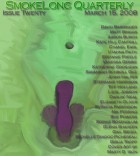Dreams are tricky to pull off in fiction. How did you make this one work?
I think, often, I have to actually immerse myself in whatever feeling or experience the character is undergoing. I do a lot of thinking when I’m driving: some of the germs of my stories develop while I’m in my truck with a particular song on repeat-play. This dream sequence is one example—elements just seem to come together, and I let them play out like little mental movies. My husband often says, before I go somewhere: “stay behind the wheel, honey” because he knows I often visit other planets while I’ve got straight highway stretches and my ‘immediate response system’ doesn’t have to be engaged.
How did this story come to you?
Whenever I went to see the photographers in Natural History, I had to pass through a maze of specimen drawers that towered over my head. Because it was just a kind of storage area, there were only ever one or two fluorescent lights on. Sometimes, the unit’s scientists assisted the police in forensic investigations and, at one point, they had Chandra Levy’s remains somewhere in the building. I often imagined the place was haunted. These memories melded with others of a college class I once took, called Archeology and Human Prehistory. The professor circulated reproductions of hominid maxillas and mandibles, and we were forever measuring their teeth, their sinus cavities, and the vaulting of their skulls. The two experiences came together when I was searching for something strange enough (because I am a great fan of the strange) for my main character David to get into. And I’m pretty certain that somewhere in the Natural History bone collection, there are some pre-human artifacts.
This is a weighty story, which is not solely due to the subject matter. What techniques did you use to give this piece its heft?
I love to interweave fact and fiction, especially scientific or historical fact. It provides a real-world anchor point, and offers some explanation for phenomena. I spend time both online and in the library researching details that make the story a bit more plausible. Also, I chose a location that I knew well, so I could get the details right. I used to work in the Smithsonian’s Natural History Building, and the details about the screaming children, the glittering minerals in the display cases—even the guards I write about in a later segment—are all things I saw there every day. Authenticity, especially of details, is really important to me.
In your bio, you mention that this flash is an excerpt of your novel-in-progress. Can you tell us more?
Definitely. Right now, I have about 245 pages, and I feel I’m close to being finished. The story revolves around three characters: David, whom we met here; his wife Rachel, who goes missing; and a character named Charlotte, who was a nine year-old Polish girl killed by Dr. Mengele at Auschwitz. The book is partly about eugenics and cloning, partly about quantum mechanics and the paranormal, and partly about human weakness. I’m hoping to have it completed in about a month.
While reading through the annual Kathy Fish Fellowship applications, I was struck by the number of writers who were using flash as, to paraphrase, a means to an end. Most people weren’t writing flash because they loved the form, because it took them places other types of fiction didn’t. Instead, they were using it as a gateway into longer works—short stories, short story collections, novels. As a champion of flash, I found this discouraging. Is flash fiction less satisfying, in terms of either writing or reading, than longer works? Or is it that the markets still haven’t accepted flash as a legitimate form? Why do you write flash, and where do you see it taking you?
My writing usually only gels if I get a strong mental image of my subject beforehand, almost like a film still. I then try to ‘freeze’ the image by writing it out as a flash piece. In a way, they’re like Polaroids. So sometimes, I do use them as a means to something longer because I can come back, examine the detail and explore the possibilities beyond the scope of the time and emotions already defined. However, I do love flash on its own and for—paradoxically—the restrictions it imposes and the freedom it offers. I had some email correspondence with Hobart Editor Aaron Burch about the flash genre, and he spoke about the necessity of precision in language. For flash, this is vital—you need to get the words just right to have the intended effect on the reader. It’s almost like minting coins: the stamper comes down fast, but the impression lasts indefinitely. In terms of the freedom factor, flash allows you to delve into something beautiful (and, possibly, experiment in the process). Yet, you aren’t committed to anything bigger, and it stands on its own. I just can’t think of anything more creatively liberating than that.



 The core workshop of SmokeLong Fitness is all in writing, so you can take part from anywhere at anytime. We are excited about creating a supportive, consistent and structured environment for flash writers to work on their craft in a community. We are thrilled and proud to say that our workshop participants have won, placed, or been listed in every major flash competition. Community works.
The core workshop of SmokeLong Fitness is all in writing, so you can take part from anywhere at anytime. We are excited about creating a supportive, consistent and structured environment for flash writers to work on their craft in a community. We are thrilled and proud to say that our workshop participants have won, placed, or been listed in every major flash competition. Community works.